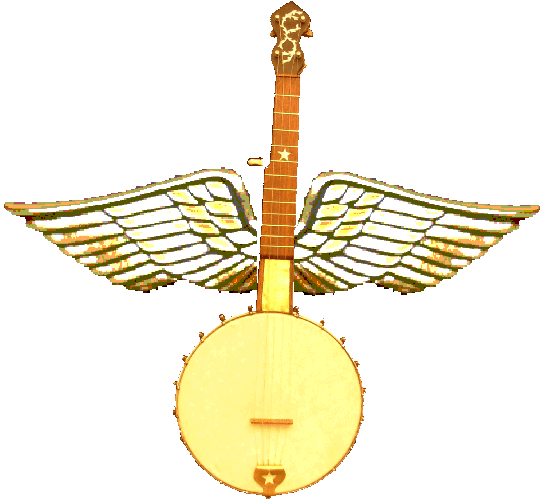-----------
-----------
-----------
Hunting
-----------
-----------
-----------
Village of Baoma, Sierra Leone

I bought a number of banjos from a collector in Nova Scotia, including some tenor banjos. I wasn't sure what I was going to do with the tenors, since I don't play tenor.
I experimented with a number of ways to convert tenors to 5-string banjos. The conversion approach that I arrived at is described in this Section. This approach can be used to restore or reconstruct a tenor or 5-string banjo a) with a severely damaged fingerboard, b) as a fretless banjo, c) as a fretted banjo with a deep frailing scoop and tall bridge, and/or d) other possibilities.
About the description "Banjos with Wings"
I took some banjos that I was working on to the Clifftop, WV festival. I saw an old friend there that I hadn't seen for a long time. I showed him one of the tenor-to-5-string conversions, and he said something like "Hmmm....... a banjo with wings ! ! ", referring to this method of widening the neck and supporting a 5-string fingerboard. I'm stealing this description from him as a shorthand for this particular way of converting tenor banjos to 5-string banjos (Thanks, D.L. ! ! !).
Guiding principles
1. A lot of old tenor banjos show rutting, fret wear, scuffing, and other signs of long, loving use. It's a shame to separate an old tenor neck that has spent decades giving pleasure to its owner (and others) from its pot. Unless a neck is too badly damaged to be useable, it's good to keep the pot and neck together.
2. Tenor banjos often have skinny necks. For many people, skinny necks are more difficult to play than slightly wider necks. It improves playability to have a neck at least 1 1/4 inch in width at the nut. String span at the nut should be no less than 1 inch.
3. My old August Pollman banjo has a very wide neck. It's an extremely comfortable-playing, fretless banjo. Wide banjo necks are OK.
4. Tenor banjos typically have a shorter scale length (i.e., distance from the nut to the bridge) than 5-strings. For some of us, shorter scale length is a little easier to play.
5. Clawhammer banjo playability is greatly helped by using a frailing scoop at the heel of the neck - improves "attack", double-thumbing, and a bunch of other, right-hand techniques. Using a scoop also lets you play further up the neck. The closer to the octave position your right hand is, the fewer "harmonics" and overtones the string produces when struck. This is good for the old-timey sound.
6. Up to a certain point, the taller the banjo bridge, the greater the down-pressure of the bridge onto the head. Greater down-pressure from bridge to head can give greater volume for a given head tension. Up to a certain point, more volume is good, esp. for banjos without tone rings. Raising the height of the fingerboard means that you need to use a higher bridge to maintain the same action.
7. String height, or "action", affects playability and sustain. Low action (i.e., about 3/16 inch at the octave) may improve clarity of noting and increases sustain. Higher action is probably not too desirable on a fretted banjo. Higher action on a fretless banjo reduces sustain, or "chops-off" notes, which is not necessarily a bad thing.
8. Nylon strings (the best, in my opinion, is "Nylgut ®) are stretchy. It takes more degrees of rotation of a tuning peg to get the same change in pitch for a nylon string than for a steel string. Therefore, violin-type pegs are fine for nylon-strung banjos. Steel-strung banjos are better off with friction pegs or geared pegs, especially for novice players.
What banjos qualify for this conversion ?
In general, older (pre-1940), well-used "work-horse" banjos, i.e., banjos that are reasonably well made, don't require major structural repair, and the neck is straight. I use a rough rule-of-thumb that if the neck is laminated (i.e., made of multiple pieces of wood joined along the center axis of the neck), then the banjo is probably of reasonably good quality. Necks with (side) bindings also often indicate a better-quality banjo.
Older Gretsch and Slingerland tenors are generally well made and take this conversion pretty well. It doesn't matter whether or not the banjo has a tone ring..... if it doesn't, then I make up a simple tone ring to replicate my Cole Eclipse tone ring (i.e., 1/8 metal rod suspended on brads around the rim).
I don't use this modification on "collectable" or unique banjos, i.e., banjos by a major maker that should stay as tenors. I don't want to make these irreversible modifications to the neck of a very good banjo. The "nicest" banjo that I've done this conversion on is Vega Style N.... one of these is currently my favorite "player" fretless banjo. UPDATE 06-07-10 - I converted a Whyte Laydie last year to fretted 5-string, and it's my main steel-string player right now. I have one Whyte Laydie conversion in the For Sale area.